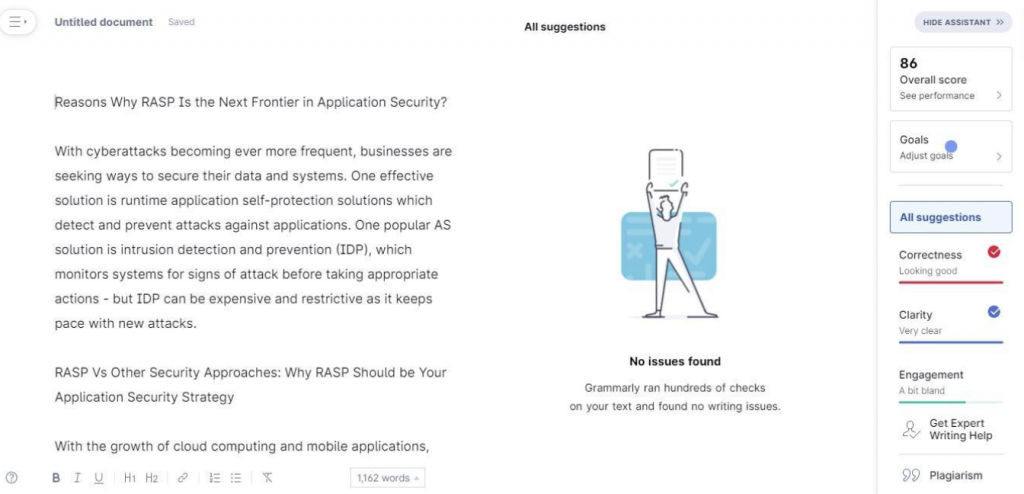With cyberattacks becoming ever more frequent, businesses are seeking ways to secure their data and systems. One effective solution is runtime application self-protection solutions which detect and prevent attacks against applications. One popular AS solution is intrusion detection and prevention (IDP), which monitors systems for signs of attack before taking appropriate actions – but IDP can be expensive and restrictive as it keeps pace with new attacks.
Why RASP Should be Your Application Security Strategy?
With the growth of cloud computing and mobile applications, application security has never been more critical. Traditional approaches, like web application firewalls (WAF), no longer suffice to protect modern apps.
Runtime Application Self-Protection (RASP) provides runtime application security that offers protection at runtime when an app is running.
RASP differs from other security approaches in two key respects. First, RASP is integrated directly into an application’s code so it can provide protection even when deployed outside a secure environment. Second, RASP detects and blocks attacks real time before they cause any lasting harm.
Thirdly, RASP does not rely on signatures or rules; thus it can protect against new and unknown attacks. Finally, RASP provides visibility into your application’s security posture so you can assess any vulnerabilities which require attention.
RASP is the next-generation of application security, quickly becoming the solution of choice among enterprises. If you need an updated security solution for your applications, RASP could be just what’s needed.
How RASP Keeps Safe?
Application Security has become a top concern. In light of all of the high-profile data breaches that have occurred recently, organizations are under intense pressure to secure their data as effectively as possible. One effective approach for doing so is with Runtime Application Self-Protection (RASP).
RASP is an advanced security technology designed to safeguard applications during runtime. While other application security solutions focus on identifying and preventing attacks, RASP detects and responds in real-time – making it an invaluable solution against today’s advanced attacks.
RASP can bring numerous advantages. First, RASP is an effective way to detect attacks that traditional application security solutions might miss due to its ability to monitor application activity and detect anomalous behaviour indicative of attacks.
RASP can protect against attacks that traditional application security solutions don’t address effectively, such as denial-of-service attacks and application layer attacks.
RASP can assist organizations with meeting compliance requirements by providing visibility into application activity and helping identify potential security threats.
RASP can significantly enhance application performance. It does this by helping to identify and prevent attacks that cause application performance issues.
Overall, RASP is an exceptional way of safeguarding applications. If you’re seeking ways to strengthen the security of your software applications, RASP should definitely be taken into consideration.
Understanding Runtime Application Self-Protection Mechanisms
Runtime Application Self-Protection (RASP) is a security technology designed to offer application-level protection from both known and unknown attacks. Utilizing static and dynamic analysis techniques, RASP detects and blocks attacks in real-time; static analysis helps identify vulnerabilities within an application while dynamic monitoring identifies unusual activity within its code base while dynamic tracking helps identify suspicious patterns of behavior within it.
RASP is still relatively new technology, with only a small handful of vendors providing solutions that include RASP. However, its effectiveness in protecting applications from attacks has made RASP quickly gain in popularity – Gartner predicts that by 2020 RASP will be required for application security by 80% of organizations.
RASP can bring many advantages, such as:
RASP can protect applications against known and unknown attacks by being application-specific and providing more precise protection than network-based security solutions. Furthermore, RASP allows administrators to monitor application activity and identify potentially suspicious behavior.
RASP provides an affordable way of protecting applications without altering them in any way. Without the need for code changes or other complications during implementation, RASP makes deployment quick and effortless.
If you are responsible for application security, RASP should be on your consideration list. RASP provides an effective means of shielding apps against attacks; its benefits make this an invaluable investment.
Advantages of RASP Over Manual Security Controls
First and foremost, RASP gives real-time visibility into app activity and threats – so that you can rapidly detect and respond to potential security incidents as they emerge rather than waiting until a security incident has already taken place.
Second, RASP can automatically block attacks without needing manual intervention from security personnel – an invaluable advantage over manual security controls which may be bypassed by attackers.
Thirdly, RASP can be tailored to your organization’s unique security requirements – this allows for customization of security protection that fits seamlessly with their organizational culture and vision.
Fourthly, RASP tends to be less costly than manual security controls because it is software-based solution which can be quickly installed.
RASP is a proactive security solution, meaning that it helps prevent attacks rather than only reacting after they have taken place.
Overall, RASP is an outstanding security solution compared to manual security controls, providing greater visibility, protection, and value for your organization.
Implementation of RASP Can Be Complex – Here Are Solutions
Application security has come a long way over time, from being an afterthought to becoming a top priority for organizations of all sizes. Once upon a time, security was something which should only be addressed after an application had already gone live – however as attacks become more sophisticated and stakes have increased dramatically, security has now become a top priority.
Runtime Application Self-Protection, or RASP, is one of the most promising new approaches to application security. RASP represents an entirely new class of security technology designed to monitor running applications in real time and protect them as soon as they launch.
RASP is an exciting new technology with lots of promise, yet it can pose its own set of unique hurdles when implemented correctly. Here, we discuss some of these obstacles and ways to address them effectively.
Lack of Visibility One of the primary challenges associated with RASP deployment is visibility issues. Since RASP protects applications in real time, it may be hard to see what’s going on inside an application at any given moment and troubleshoot issues or understand why an attack bypassed its security measures.
To address this challenge, it is imperative to implement an efficient logging and monitoring strategy that allows you to observe what’s going on inside the application as well as quickly identify any issues or risks.
False Positives
RASP users sometimes face the frustration of false positives due to RASP’s incessant attempts at blocking any suspicious activities; unfortunately, this means that it may also block legitimate ones, creating extra work and time-wasting by trying to address false positives manually.
To overcome this challenge, it is key to tailor your RASP system specifically to your requirements in order to reduce false positives and make it more effective at blocking actual attacks.
High False Negative Rate
While false positives may be infuriating, having an alarmingly high false negative rate can be even more hazardous to your application’s security. RASP might miss many attacks that pose real threats that leave it open to serious harm – leaving your app susceptible to significant risk.
Conclusion
RASP stands apart as the next level of application security because it provides real-time, runtime protection from attacks. RASP with Appsealing detects and blocks attacks as they happen rather than waiting until an attack happens and then trying to mitigate it; making RASP an invaluable form of proactive protection that’s required in today’s threat environment.














